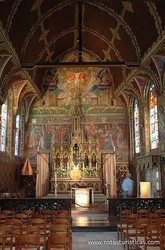




The Basilica of the Holy Blood (Dutch: Heilig-Bloedbasiliek, French: Basilique du Saint-Sang) is a Roman Catholic minor basilica in Bruges, Belgium. Originally built in the 12th century as the chapel of the residence of the Count of Flanders, the church houses a venerated relic of the Holy Blood allegedly collected by Joseph of Arimathea and brought from the Holy Land by Thierry of Alsace, Count of Flanders. Built between 1134 and 1157, it was promoted to minor basilica in 1923.
The 12th-century basilica is located in the Burg square and consists of a lower and upper chapel. The lower chapel dedicated to St. Basil the Great is a dark Romanesque structure that remains virtually unchanged. The venerated relic is in the upper chapel, which was rebuilt in the Gothic style during the 16th century and renovated multiple times during the 19th century in Gothic Revival style.
In 1134, Thierry of Alsace decided to build a private double chapel next to the Oud Steen, the first residence of the Counts of Flanders, transformed today into the town hall of Bruges. Thierry went on crusade a second time in 1147 during the Second Crusade. According to the tradition, Thierry of Alsace returned to his capital Bruges on April 7, 1150, with the relic of the Precious Blood. During the first half of the 13th century, the name of the upper chapel was changed to the Chapel of the Holy Blood.
The chapel of Saint Basil is one of the best preserved churches in Romanesque style of West-Flanders. Built from 1134 to 1149, the chapel is dedicated to St. Basil the Great of whom a relic was brought back by Count Robert II from Caesarea Mazaca in Cappadocia, Asia Minor (modern-day Turkey).
The chapel consists of two side naves and a central nave continued by the choir, which in turn is ended by a semi-circular apse. In the tympanum above the entrance linking the chapel and the annex is a 12th-century representation of the baptism of Saint Basil. In the right nave, the seated Madonna and Child (Sedes Sapientiae) is a wooden polychrome sculpture of the early 14th century. Carried each year during the procession, two venerated wooden statues, made around 1900 and representing Jesus on the Cold Stone and the Pieta are displayed.
At the left of the choir, the chapel of Saint Yves was added in 1504 and houses the relics of Saint Basil and of Blessed Charles the Good, Count of Flanders. The black marble retable is allegedly executed from designs by Lancelot Blondeel.
The 12th-century basilica is located in the Burg square and consists of a lower and upper chapel. The lower chapel dedicated to St. Basil the Great is a dark Romanesque structure that remains virtually unchanged. The venerated relic is in the upper chapel, which was rebuilt in the Gothic style during the 16th century and renovated multiple times during the 19th century in Gothic Revival style.
In 1134, Thierry of Alsace decided to build a private double chapel next to the Oud Steen, the first residence of the Counts of Flanders, transformed today into the town hall of Bruges. Thierry went on crusade a second time in 1147 during the Second Crusade. According to the tradition, Thierry of Alsace returned to his capital Bruges on April 7, 1150, with the relic of the Precious Blood. During the first half of the 13th century, the name of the upper chapel was changed to the Chapel of the Holy Blood.
The chapel of Saint Basil is one of the best preserved churches in Romanesque style of West-Flanders. Built from 1134 to 1149, the chapel is dedicated to St. Basil the Great of whom a relic was brought back by Count Robert II from Caesarea Mazaca in Cappadocia, Asia Minor (modern-day Turkey).
The chapel consists of two side naves and a central nave continued by the choir, which in turn is ended by a semi-circular apse. In the tympanum above the entrance linking the chapel and the annex is a 12th-century representation of the baptism of Saint Basil. In the right nave, the seated Madonna and Child (Sedes Sapientiae) is a wooden polychrome sculpture of the early 14th century. Carried each year during the procession, two venerated wooden statues, made around 1900 and representing Jesus on the Cold Stone and the Pieta are displayed.
At the left of the choir, the chapel of Saint Yves was added in 1504 and houses the relics of Saint Basil and of Blessed Charles the Good, Count of Flanders. The black marble retable is allegedly executed from designs by Lancelot Blondeel.
| Partilhado por: Cristina Nascimento | Ainda Sem comentários |
| Visualizações: 3981 | |
Partilhe os locais de interesse a serem visitados, locais que visitou nas suas férias, ou locais na sua terra que pretenda promover.
Coordenadas GPS
Lat : 51.208134 - Lon : 3.226545
N51° 12' 29.2824 " E3° 13' 35.562"
Comentários
Ainda não tem comentários para
Basilica of The Holy Blood
Se conhece Basilica of The Holy Blood Deixe o seu comentario
Basilica of The Holy Blood
Se conhece Basilica of The Holy Blood Deixe o seu comentario
OBRIGADO

